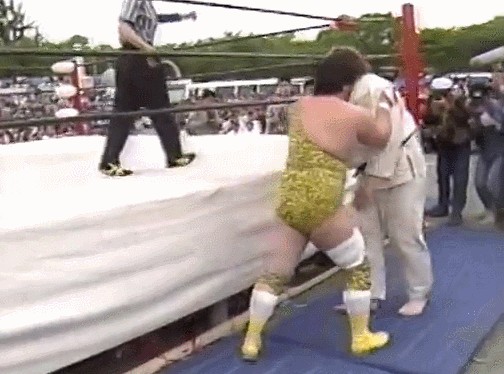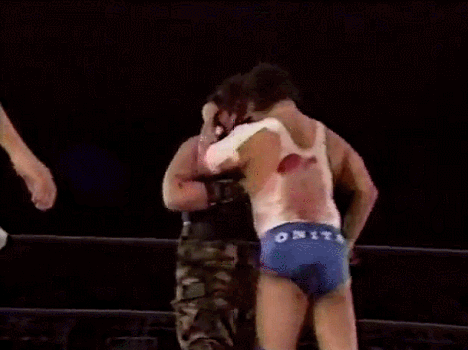This was a Different Style Fight for Onita’s WWA Brass Knuckles Heavyweight Title.
Verichev is the latest in a long line of shoot fighters to go after Onita in FMW’s early days, but with all due respect to Aoyagi and the future Jerry Flynn and Lee Gak Soo, Verichev is a little different. Not just as a Russian fighter, which every even reasonably well-informed wrestling fan knows is the most dangerous thing possible, but also as a bronze medalist at the 1988 Olympics, and a medalist in the last three world championships. On top of that, he’s been in FMW regularly for four months now, pretty much running through everyone put in front of him in around five minutes or less.
Essentially, what worked before likely will not work now, Verichev is another type of being entirely, and ought to be taken so much more seriously than any other genuine fighter to come through FMW.
The joy and tragedy, of course, is that Onita is the last one to know this.
It’s a great match in the way that I love for matches to be great, successful for two different reason, with each working together in perfect synchronization to create some real beautiful pro wrestling.
What I love about this, as a wrestling match, is first, that it rules. Verichev is the perfect guy for this match and story, as a big man who is impressive without being immediately imposing, allowing his dominance in the back half to not totally come out of nowhere, but to strike from a less familiar angle. All of his throws look like absolute hell to take, and Onita’s selling is perfect. He’s able to convey less and less hope and greater desperation each time he gets up, he’s able to inject that into his limited offense as well, and it makes a finish that reads as a little whatever on paper into one of the more striking and memorable scenes in FMW history.
It’s another one of those perfect examples of every single thing in a match stacking on top of what came before it, creating something memorable and enhancing it at the same time. So, while yes, things like the Onita fire ups and all Verichev’s gorgeous and nasty throws are all super fun to look at and so easy to enjoy on a gut level, there’s also such a utility to everything. Every move and motion and look is not only itself good as hell or, at worst, effective, but contributes to the larger whole in the way that’s so impressive, while also working with an efficiency that a lot of other matches I would praise (and have praised before) like that don’t even come close to.
What I love about this too, more narratively speaking, is that much like most great tragedies, it is completely understandable why Onita makes every choice that he does.
Having survived most of this sort of thing before, along with now tons of barbed wire and explosions, it makes sense, in a sort of a ROCKY III or ROCKY IV sort of a way. It’s plainly hubris, but it’s a well-earned hubris that anyone with a little knowledge of the history of the promotion so far can understand. Likewise, his approach is essentially one crafted by other matches like this. He lays low in the first half on the ground, just staying alive in there, before striking with the classic Onita stuff, and it makes sense, because this is what’s worked before.
It just doesn’t work at all this time, or even close.
The very moment Onita leaves Verichev open, everything collapses.
Verichev crowds him with throws, and for the last three or four minutes of the match, the only shot Onita gets in is a weaker-than-usual Lariat, and it’s one that Verichev tops right after when he completely wipes out Onita with one of his own. Onita’s headbutts — in one of the great bit of visual shorthand ever — only break open Onita’s forehead and not Verichev’s, calling into question if he can be killed or not, but more than that, showing Our Hero as being literally unable to leave a single mark upon his challenger. Judo throws lead to slams lead to the repetition of these nasty nasty side belly-to-belly suplexes, and after eight or nine, Onita just cannot do it anymore.
In one of the best executed versions of the idea ever, that the spirit is willing but the flesh is weak, Onita grabs onto Verichev’s gi on his knees at the count of eight, but cannot make it all the way back up to his feet by ten. Onita collapses, losing his title to an outsider finally, as Verichev stands over him with his arms raised.
For what it lacks as a match, it makes up for as pure pro wrestling brilliance.
It isn’t new, and anyone reading this likely knows a rematch will come, along with all that will come with it. That doesn’t matter to me, not when the set up is this great. Onita suffers his first genuine defeat since the very first FMW show, and it isn’t even a close one. It’s ideal action movie shit, Our Hero so used to his success against all comers that he doesn’t just lose a close one, but gets completely obliterated, so as to establish a beautiful triumph to come in the future, and with that in mind, it achieves this goal totally and completely.
The match just happening to also be great is a fun little bonus on top.
Not a pristine chunk of chaos or high-level violence, but more in line with the very first FMW shows. Classical pro wrestling ass pro wrestling and, to be perfectly honest, also some of the best Inokiism of the 1990s to date as well.
***



